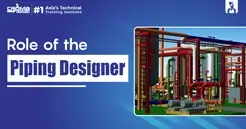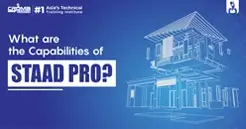What Do The Piping Designers Do?
4.9 out of 5 based on 1236 votesLast updated on 30th May 2023 6.3K Views
- Bookmark

Croma Campus offer Piping Design Online Certification training to help individuals learn more about this field and build a secure career as piping professionals.

Introduction
The piping system refers to the system of pipelines used to transport fluids like water, gas, oil, etc. Piping designing involves designing and developing the pipes and other equipment used in the pipeline system. A Piping Designer is an engineering professional who utilizes computer-aided designs and drafting systems to develop effective piping isometrics, plot plans, and other drawings required by other construction professionals to build the pipeline plant. The Piping Designers are highly skilled in CAD software; analytical, planning and imagination skills; and have the ability to understand the designs created by other Piping Developers. They use tools and software like AutoCAD, PDMS, E3D, Revit, etc., to develop effective and safe pipeline designs to transport the fluids in different parts of the pipeline plantation.
The Piping Designers are among the most valuable members of the piping industry, with an average salary package ranging between Rs. 2.7 LPA to Rs. 12.1 LPA in India. Piping Engineering and Designing is a growing and secure career path. Therefore, many training institutes offer Piping Design Online Certification training to help individuals learn more about this field and build a secure career as piping professionals.
This blog explains the different roles and responsibilities of Piping Designers. Read on to know more.
Roles And Responsibilities of Piping Designers
As mentioned earlier, Piping Designers are skilled professionals who use computer-aided designs and drafting systems to develop effective piping isometrics, plot plans, and other drawings other construction professionals need to build the pipeline plant.
Let us look at the key roles and responsibilities of the Piping Designers in detail.
- The Piping Designers communicate the ownership responsibilities across various department platforms to achieve the 3D modeling of HVAC, steel and other equipment required for project success.
- The Piping Designers manage the documentation of the existing projects and perform ECN resolutions.
- These professionals develop detailed 2D engineering drawings with the help of tools like AutoCAD, PDMS, NavisWorks, etc.
- The Piping Designers use PDS to design and fix models and use the API codes to qualify the process equipment.
- They work as the piping discipline sub-lead and piping checker and perform Field sketches to design different maintenance and capital piping projects.
- The Piping Designers perform Route Gas Piping using carbon and stainless specs with CADWORX.
- The Piping Designers perform the role of drawing checkers for the mechanical group. In addition, they create 3D Solidworks models of pipe installations.
- These professionals check and design the Steam Piping Systems with the help of PDS Piping and Equipment Modeling.
- The Piping Designers are responsible for directing the CAD operators on the new Steam Piping layout and installation of the meters.
- The Piping Designers use ASME and API codes or standards to analyze the piping systems code requirements and use CADWORX to develop and modify different piping models in an oil field industry.
- The Piping Designers are responsible for overseeing the installation of the new Condensate Return Piping System.
- The Piping Designers work in developing isometric piping drawings from orthographic plans and elevations.
- They Stress qualify the piping systems and analyzed the steam systems.
- The Piping Designers implement the MEP design and drafting for the Irving office. They upgrade the piping and structural drawings of the existing refinery and compressor stations in a plantation.
- The Piping Designers are responsible for creating piping and structural platforms. In addition, they design the mezzanines for the refinery and the manufacturing industries.
- The Piping Designers interpret and apply the BP piping standards and API and ANSI codes to all their projects.
- These professionals design the heating and ventilation systems and develop various high-pressure flare isometric drawings.
- The Piping Designers check the completed projects and revise the documentation through modifications. Furthermore, they create Pro/E PDM models, detail various pipeline parts, assemblies, and lift devices and fixture the layouts.
You May Also Read:
Is Piping Designing A Worth Learning Course
Future Scope Of Google SketchUp
Conclusion
To summarize, the Piping Designers are one of the most valuable members of a pipeline plantation. These professionals are highly skilled in CAD software, analytical, planning and imagination skills, and use different tools and software like AutoCAD, PDMS, E3D, Revit, etc., to develop effective and safe pipeline designs to transport the fluids in different parts of the pipeline plantation. They work as the piping discipline sub-lead and piping checker, manage the documentation of the existing projects, develop detailed 2D engineering drawings, and perform several crucial tasks to ensure a safe and effective pipeline design and implementation. Over the years, there has been a steady rise in the demand for Piping Designers. Therefore, aspiring professionals must consider joining the Piping Design Course in Noida to learn more about this field and make significant career advancements. Piping designing is a valuable career option and ensures great scope in the industry.
Subscribe For Free Demo
Free Demo for Corporate & Online Trainings.
Your email address will not be published. Required fields are marked *


.webp)


















 Master in Cloud Computing Training
Master in Cloud Computing Training